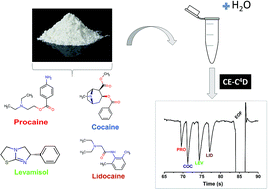Fast determination of cocaine and some common adulterants in seized cocaine samples by capillary electrophoresis with capacitively coupled contactless conductivity detection†
Abstract
The determination of cocaine and common adulterants in seized cocaine samples can be used to identify their possible production area and traffic routes. In this paper, capillary electrophoresis with capacitively coupled contactless conductivity detection (CE-C4D) was used for fast simultaneous determination of cocaine (COC), procaine (PRO), levamisole (LEV) and lidocaine (LID) (38 injections per hour). The separation was achieved using a fused silica capillary (50 cm total length − 40 cm effective length, 50 μm i.d.) and a background electrolyte composed of boric acid/3,4-dimethoxycinnamic acid (20/10 mmol L−1) with pH adjusted to 8.4 with sodium hydroxide. Linear working ranges (r ≥ 0.996) were obtained from 100 to 900 μmol L−1 for COC and from 50 to 450 μmol L−1 for PRO, LEV, and LID. The limits of detection were 10, 4, 6, and 7 μmol L−1 for PRO, COC, LEV and LID, respectively. In addition, the proposed method also provided adequate intra (≤2.3%) and inter-day (≤4%) precisions, as well as satisfactory recovery values for spiked seized cocaine samples (from 96% to 103%).



 Please wait while we load your content...
Please wait while we load your content...